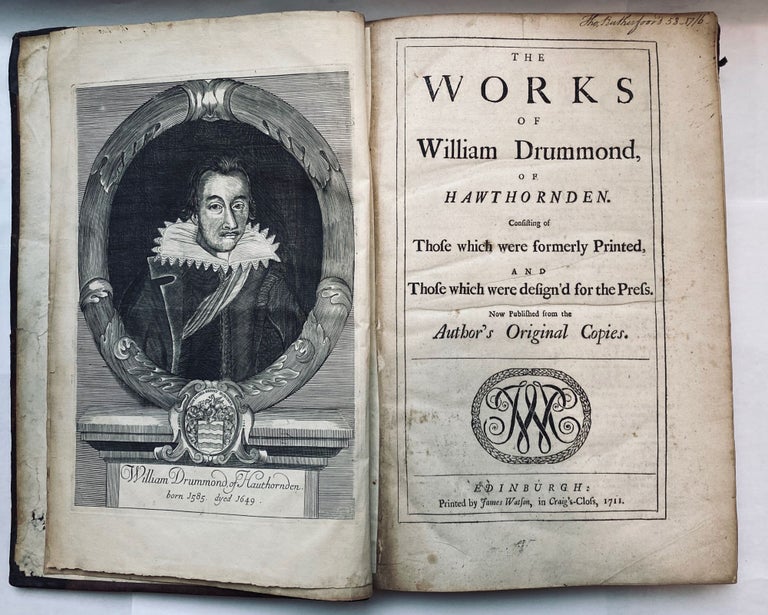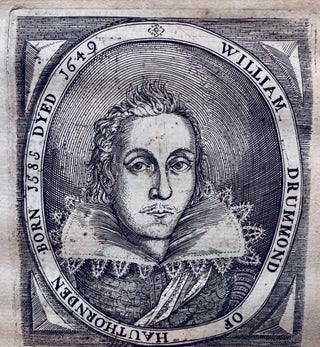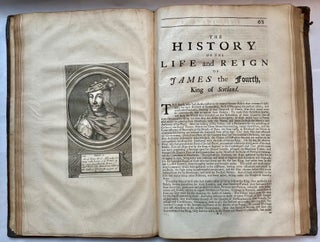The works of William Drummond, of Hawthornden. Consisting of those which were formerly printed, and those which were design'd for the press. Now published from the author's original copies
Edinburgh: 1711. printed by James Watson, in Craig's-Closs, 1711.
Printed: 1711 Folio, First collected edition [4],xlv,[3],243,[1];iv,60p,plates : ports ; 20 William Drummond is the last significant figure in Scottish poetry before the Eighteenth Century The gap between him and Alan Ramsay indicates a crisis in Scottish literary culture brought on by the departure of the Scottish court to London with the accession of James VI of Scotland to the throne of Great Britain James had been a patron of poets, dabbled in poetry himself and delivered himself of Rewellis and Cautelis [Do's and Don'ts] for its composition Not only had the court been a centre of literary activity where men of letters such as Drummond's uncle, William Fowler, and his friend William Alexander of Menstrie, later Earl of Stirling, gained employment, it had also given authority to Scots as a literary language These conditions were now abolished Poets who had published their work in Scots, followed James in revising it and publishing it in English, and Drummond, who did not go south with the court, was left in a state of cultural bereavement He made a lot of that melancholy state He became a poet of retreat and death, like Henry Vaughan during the Interregnum
Drummond was born in 1585, the eldest son of John Drummond, descended through a cadet branch from the Drummonds of Stobhall, Lords Drummond of that ilk since 1471, and of Susannah Fowler, daughter of a well-connected Edinburgh burgess John Drummond acquired the property of Hawthornden, where the North Esk runs through a romantic gorge near Dalkeith, and was made gentleman usher at the court of James VI in 1590 William Drummond was educated at the High School in Edinburgh and at Edinburgh University, where he graduated MA in 1605 He completed his education by travelling to France, visiting Paris and studying law at Bourges On the way out and on his return in 1609, he stayed in London He became laird of Hawthornden on the death of his father in 1610 and thereafter seldom left his estate, where he dedicated himself to literary pursuits, accumulating an excellent library and rebuilding the house as a Scots baronial mansion
Like everyone else he published a lament on the death of Prince Henry in 1613, "Teares on the Death of Moeliades" Poems followed in 1614; most of these were included and revised in the 1616 edition, whose first part is a celebration of a love for Auristella and the second a mourning of her death The "Teares" for Prince Henry is included and there are additional madrigals and epigrams, but the main body of the collection is a two part series of sonnets and songs like Sir Philip Sidney's Astrophil to Stella and Sir William Alexander's Aurora Drummond was a late practitioner of the Petrarchan sonnet sequence in English, but he worked in phrases and ideas of the French and Italian masters of late petrarchism Marino was an author he admired and imitated The language he writes in is not the Scots he spoke but a literary English, as correct as he could learn to make it from reading books His art aims at refined sweetness both in versification and in the preciosity of his reworking and tinkering with petrarchan imagery The landscape of his love-melancholy is a solitary and Arcadian Midlothian
On this colde World of Ours,
Flowre of the Seasons, Season of the Flowrs,
Sonne of the Sunne sweet Spring,
Such hote and burning Dayes why doest thou bring?
(Madrigal vi, ll 1-4, Poems, Part 1)
The love affair he writes about so artificially has a very oblique relation to his life His Auristella has at least some connection with Euphemia Cunningham, who lived by the Ore, or Ora as he has it, in Fife Like Poe, Drummond seems to have felt that the death of a beautiful woman was the best subject for poetry and Euphemia Cunningham did her best for him in this respect Only a year after he had completed the Poems that end in mourning her literary epiphany Religion was another source of melancholy interiority that he exploited; he expanded the divine poems of the 1616 collection and brought them out as Flowres of Sion in 1623 The volume includes his prose meditation on death, The Cypresse Grove In 1617, James visited Scotland, and joining in the public rejoicing, Drummond published "Forth Feasting" to celebrate the occasion
Drummond's Poems were a success He had already made the acquaintance of Alexander in 1614 on a chance visit to his house in Menstrie; he records the hospitality and literary chat in an attractive letter Through Alexander, he struck up an epistolary friendship with Michael Drayton; and Ben Jonson visited him in the summer of 1618, having walked up to Hawthornden from London The notes of his talk are among the best things Drummond wrote
In the years after the death of Euphemia Cunningham, Drummond kept a mistress by whom he had three illegitimate children In 1632 he married Elizabeth Logan, and by her had nine legitimate ones He wrote a welcome for the visit of Charles I to Scotland in 1633, but his literary activity had dwindled He wrote an essay on impresas and anagrams and some coarse satirical squibs and epigrams, which display an interesting obverse to the aesthetic refinement of the poetry he is most known for He followed the Scottish virtuoso, John Napier of Merchiston, in thinking up machines for the destruction of mankind or improvements on those already in use and applied for a patent in 1626 In later years he began to compile an uninteresting royalist History of Scotland The Bishops' Wars between Charles I and the Scots Presbyterians and the involvement of the Covenant in the politics of the English Civil War stirred Drummond to write political tracts against the Covenanters, notably Irene in response to the promulgation of the National Covenant of 1638 and Skiamachia in support of the Cross Petition to the Scottish Parliament against moves for an alliance with the English Parliamentarians He did not publish them but they probably circulated in manuscript Too literary, written in too elaborate and beautifully modulated a style to engage effectively in the cut and thrust of Civil War polemic, they nevertheless make shrewd points about the contradictions in which the Covenanters had involved themselves Here is his address in Irene to the Covenanting churchmen who meddle in politics:
Yee lightes of the World, examples of Holiness and all Vertues, you living libraryes of Knowledge, Sanctuarryes of Goodnesse, looke upon the weaknesse and fragilitie of Mankynd! The Bodyes of Common wealthes are alreddye turned in Skeletones, the Cityes in Sepulcheres, the fieldes in Shambles, the Trees in Gibbetes Pittye humaine Race, spare the blouud of Man: the earth is druncke with it, the Watteres empurpled, the aire empoysoned, and all by you, for, who give advice and counsell for the performing of evill actiones, cause them, and doe these actiones themselves: and they who command them and approve them when done are beyond he actores guilty
Drummond died "of a sort of gravell", harassed by debt and distressed by the execution of his King in 1649 The non-juring bishop, John Sage, brought out an edition of his works in 1711, which, along with the poems, includes some of his letters, his history of Scotland and not very reliable versions of the political works
Lowndes, p 675 who reports that Ben Jonson thought of Drummond as a 'Scotian Petrarch'
‘Drummond was friend of poets Michael Drayton and of Sir William Alexander, Earl of Stirling, an acquaintance of Ben Jonson and a supporter of King Charles I. He graduated from the Tounis College (now the University
of Edinburgh) in 1605 before proceeding to further study at Bourges and Paris in 1607 amd 1608. He published various works of verse as well as some political pamphlets. Drummond began collecting books soon after he graduated, and amassed a superb private library. It has provided the University Library with some of its greatest treasures, especially in the fields of literature, history, geography, philosophy and theology, science, medicine and law. They include two Shakespeare quartos, and works by Jonson, Spenser, Drayton and Sir Philip Sidney. There is also a complete copy of John Derrick's “Image of Irelande” (1581), and two early pamphlets encouraging the colonisation of Nova Scotia’ (ibid.).
Price: $2,500.00






